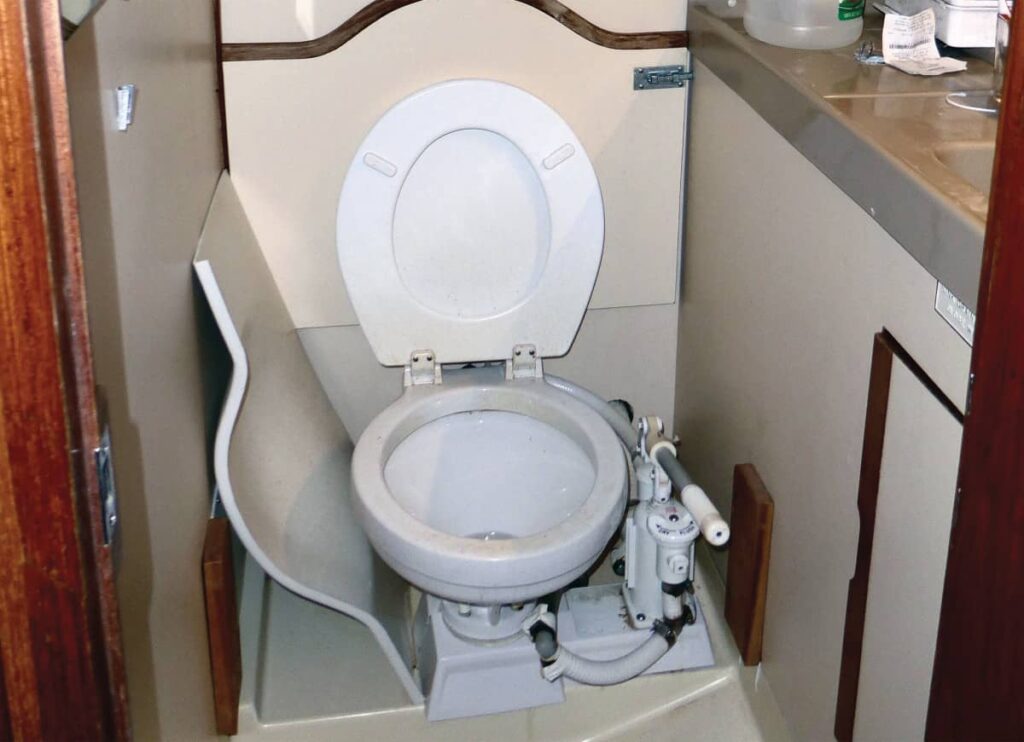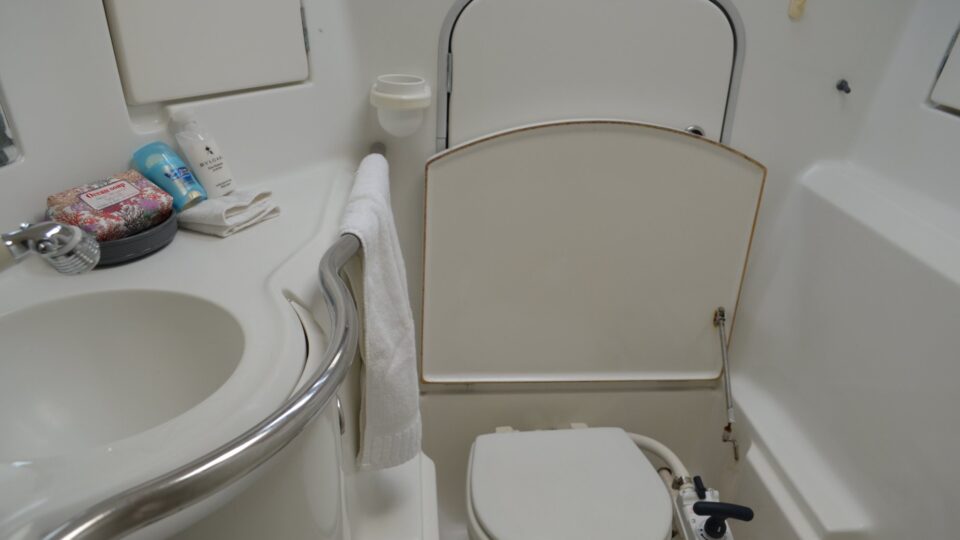Common Marine Toilet Problems and Maintenance
Are you having problems with your sailboat’s sanitation system, and more specifically with the marine toilet? No need to worry, I have the right solutions for you. Most problems with marine toilets are caused by a lack of proper maintenance, or an attempt to flush thick matter through the system. It’s important to regularly maintain the sanitation system in order to prevent these common problems listed below. Like this, you’ll have your entire system working reliably.
General Rule When It Comes To Waste Disposal on a Boat
As stated by The International Convention for the Prevention of Pollution from Ships, wastewater and feces have to be collected in a waste tank onboard and can only be disposed of when the boat has reached a certain distance from the shore. In some regions though disposal on inland waters is strictly prohibited. Therefore, the tank contents have to be thrown via a specific vacuum sewerage system in the port.
Types of Sailboat Toilets
The most important requirements of any marine toilet (or heads as they are called onboard), must have the sufficient capacity to evacuate the contents of the bowl in a single flush. Furthermore, it has to rinse the bowl in order to reduce staining and prevent odors that reach the bowl from the holding tank. A good marine head would ideally involve water usage, electrical draw, minimal noise, and easy installation. So, let’s see the types of marine heads!
Manual Marine Toilets
These onboard toilets come without a flushing system. They use a manual hand pump instead which is positioned on the side of the toilet bowl. This pumps clean water into the toilet bowl while effectively emptying the contents of the toilet by using a switch valve. The main benefit of a manual on-board marine toilet is the low cost of purchasing and the easiness of maintaining. On the other hand, this type of toilet has a complex operation and clogs easily. Keep in mind to use a Marine Sanitation Grade hose in order to discharge all pipework and avoid odor permeation. Also, consider using double clips on all pipework connections to avoid leaks.
Electric Marine Toilets
Electric toilets are generally more compact, and less expensive than manual-pump toilets. Their advantage is that they have automatic electric macerating pumps that are efficiently eliminating waste. Electric toilets suck the flush water in through a 12v pump. There’s also another pump that carries the waste into the holding tank or in the sea (worst-case-scenario). In any case, if you want to upgrade your old manual toilet to an electric one then you must take into account plumbing details. Moreover, conversion to electric ones also requires additional power requirements, over-current protection, and wiring details.
Portable Marine Toilets
Porta-potties toilets are entirely self-contained units and are easily installed. Their waste falls by gravity into a detachable tank beneath the bowl and is periodically taken off the sailboat and emptied. Also, they can operate with either an electric flush or a manual one. Usually, trailer or occasional sailboats tend to use them because they hold small amounts of waste, until 6 gallons. It’s a temporary solution because they eliminate the need to install permanent plumbing, are affordable and they don’t easily clog. Consider adding a deodorizing chemical to the tank in order to keep them odor-free.

Most Common Problems and How to Fix Them
Water Leaks
Leaks next to the pump handle can be one of the most common problems. Especially on some Jabsco and Raritan models when they haven’t been serviced for a long time. However, there’s no need to worry about your health because the water that escapes here is the seawater which is used for flushing. Usually, it can be easy to fix the leak. The problem might come from a worn or perished seal around the rod to which the pump handle is attached. You can just simply unscrew the large plastic nut on top of the pump to reveal the old seal. Generally, heads that are flushed with salt water accumulate scale deposits in the discharge hoses. In other words, scale deposits make it harder to flush and allow water in the discharge line to leak back into the bowl.
Joker Valves
These are the rubber valves through which waste passes with each manual throw of the pump lever. Remember that the larger the valve, the less risk of a clog. The valves situated at the exit of the pump might also become gummed up with calcium deposits. This will impact their operation to the point at which the pump will no longer function properly. So, if you notice severe difficulty for the toilet to flush away the contents of the bowl, it’s probably because of the valves. In case the joker valve fails to seal, then it will also tend to draw in the contents of the waste pipe. Moreover, when a pump ages its rubber components become more fragile. You can replace the joker valves by simply using the service kit of the pump which contains replacements.
Calcification
Sometimes the outlet pipework becomes progressively clogged up with calcium deposits. Well, this is a difficult problem to diagnose. This is due to the fact that this problem is not that obvious, thus it makes it easy to fail to spot the early signs of impaired performance. So, try to regularly flush with white vinegar through the head once a month. The acidic vinegar dissolves the scale that’s inside the head and hoses. When the vinegar has passed through the toilet’s system, pump a gallon of fresh water through to flush the lines.
Smells
There are two main reasons that cause odors. The first reason is that the outlet hoses are not of a proper sanitary grade and the boat toilet smells when flushed. The second possible reason for getting sewage type smells in the sailboat might be leakage on the outlet side of the system. If that’s the case, check the water’s quantity in each of the joints in the plumbing with a dry cloth (there are leaks that are hard to spot by the naked eye). Another smell that may be experienced is that of hydrogen sulfide (like rotten eggs). This is a result of the bacterial breakdown of organic matter in an environment that lacks oxygen. This problem is most frequent on low sailboat use. It can be solved by installing a chemical treatment in the inlet pipe or a freshwater flush system.
Blockages
This is one of the worst problems to happen, but if you regularly maintain your sailboat’s sanitary system, there’s no need to worry. But in case this happens never use too much force to propel a blockage through the system. Usually, most of the blockages will become more flexible over time and thus they’ll pass through the system more easily. In case the blockage won’t move then the only solution is to take the pump apart.
Marine Toilet Problem-Prevention and Maintenance Tips
- Use only biodegradable toilet paper!
- Keep your batteries charged to ensure an effective flush on electric pump-out models.
- Never discharge your sailboat’s sewage irresponsibly. It’s vital to protect the environment you use for recreation, so get acquainted with the local pump-out facilities.
- Easy tip: one part of bleach to ten parts of water kills any bacteria in any cleanup.
- Prior to clean, haulout flush, and pump remember to dry your holding tank.
- Go green and try using nitrate, enzyme and bioactive treatments instead of chemicals, or even installing composting toilets for your sailboat.
- To ensure better refinement and a more civilized emptying operation, a pump-out toilet is the best option.
Marine Toilet Problems – Conclusion
The most important thing for your sanitary system is to regularly maintain it. Maintaining your marine sanitation system can be a burden, but if you don’t neglect to do so, it is unlikely that you’ll deal with any problems. But, if you face a problem with blockages, valves, or holding tanks it’s recommended to apply the above-mentioned solutions or replace the problematic parts of the system. So make sure to check your heads regularly and know how to fix these problems, in case you are away from assistance.
